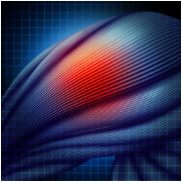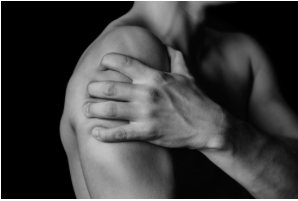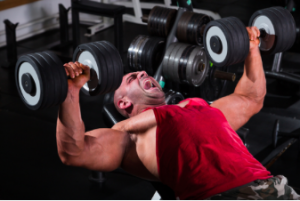What fats are best for gaining muscle and losing fat?
When it comes to body composition omega-3s are the top fat to consume. Unfortunately for most we get far too ...

When it comes to body composition omega-3s are the top fat to consume. Unfortunately for most we get far too ...
There is no need to go into detail about how important shoulder development (specifically deltoids) is to a complete physique. ...
Leucine is the most important of the BCAAs. When it comes to signaling muscle building (protein synthesis), Leucine is King ...
Muscles store carbohydrates exclusively as glycogen, which is basically a long chain of glucose molecules linked together. The level of ...
If you’re wondering around the health section at your local grocer, it will be hard not to find a product ...
One of the best strategies you can apply with success to a bodybuilders diet is protein rotation. In essence, eating ...
In preparation for writing this article, I wanted to see what exactly was written out on the web when it ...
From boosting testosterone production & supporting lean muscle growth, to optimizing joint health & immune function, getting enough of this ...
It is true that a person’s caloric intake has a very direct impact on their weight. Consume more than is ...
In what situations should I take carbs pre-workout? There is no situation where you NEED pre-workout carbs, but there are ...
Part 2 of good cop versus bad cop in the fat loss hunger wars - this time we’ll focus on ...
Let’s face it – seeking out the right information can be confusing whether you are a bodybuilder or just an ...
 Most hard working bodybuilders, from rank beginner to seasoned pro, will experience some degree of training-related muscle soreness. Whether experienced as mild discomfort or more debilitating, the post-training Delayed Onset Muscle Soreness (or DOMS) suggestive of an intensive workout is, for many, a sure sign that a maximum number of muscle fibers have been taxed with a level of ferocity which results in the growth of new muscle tissue. Many have come to believe that an absence of post-workout pain is indicative of a wasted workout.
Most hard working bodybuilders, from rank beginner to seasoned pro, will experience some degree of training-related muscle soreness. Whether experienced as mild discomfort or more debilitating, the post-training Delayed Onset Muscle Soreness (or DOMS) suggestive of an intensive workout is, for many, a sure sign that a maximum number of muscle fibers have been taxed with a level of ferocity which results in the growth of new muscle tissue. Many have come to believe that an absence of post-workout pain is indicative of a wasted workout.
On the other hand, there are those whose post-workout soreness is such that it may impinge upon their day to day activities (hair brushing and stair walking may become arduous tasks in the days following intensive chest, and leg, training sessions). Such pain may also give lifters the impression that connective tissue damage has occurred, or that the actual muscle itself has been torn. However, after several weeks of this soreness and upon hitting the gym to work the same area, with greater strength and, in some cases, greater muscle volume these individuals invariably come to the realization that such pain, due to the training that produced it, has in fact paid dividends.
In short, post-workout soreness is often used to assess the productivity of our workouts. While inconvenient for some, muscle soreness can also double as a valuable monitoring tool, providing feedback to ensure that we eat and rest properly and structure our training in an appropriate way. There are also those whose dislike of training-induced muscle soreness has prompted them to reduce their training intensity – wrong move! Then there are those who experience very little post workout soreness, yet still continue to grow. What gives?
How does DOMS occur and why?
Why must we covet such sweet pain?
And is such soreness really necessary?
Read on as I unravel the mysteries of this crucial aspect of the muscle building process.
How training-induced soreness occurs
Usually beginning within 24 to 72 hours after training and lasting for 2-3 days, DOMS is characterized by the occurrence of swelling (localized muscle inflammation), stiffness and an acute, temporary loss of strength in some cases.
While pain and training productivity are frequently linked, there are different types of muscle soreness, and it is important to  distinguish between them. The discomfort experienced during training, resulting from lactic acid accretion (a metabolic byproduct of the glucose oxidation process) is not indicative of muscle microtrauma (the microscopic tearing of muscle fibers). It certainly does not directly contribute to DOMS. However, this type of soreness (marked by a burning sensation and degree of tightness which limits us in our training output) does mean we have trained within the upper limits of our anaerobic threshold and, for muscle building purposes, this is essential. Then there is the acute, sudden and sharp pain of injury which occurs during training and which may cause swelling or bruising. Obviously, this kind of pain is to be avoided at all costs.
distinguish between them. The discomfort experienced during training, resulting from lactic acid accretion (a metabolic byproduct of the glucose oxidation process) is not indicative of muscle microtrauma (the microscopic tearing of muscle fibers). It certainly does not directly contribute to DOMS. However, this type of soreness (marked by a burning sensation and degree of tightness which limits us in our training output) does mean we have trained within the upper limits of our anaerobic threshold and, for muscle building purposes, this is essential. Then there is the acute, sudden and sharp pain of injury which occurs during training and which may cause swelling or bruising. Obviously, this kind of pain is to be avoided at all costs.
In actuality, it is structural damage resulting from muscle breakdown which signals muscle growth and the soreness which accompanies the post workout rebuilding phase. To rebuild we must first recover. Too little rest between workouts and we will not reach our full growth potential, or experience any growth at all. Minute muscle tears are produced each time we train with optimal intensity. Such injury to muscle tissue causes localized inflammation, for the most part a by-product of the lengthening (or eccentric loading) of muscles as opposed to the contracting (or concentric) aspect of a rep. Thus we experience DOMS, in addition to the acute muscle soreness which is felt during, and immediately following, intensive workouts. A positive response and adaptation to muscle damage is necessary to prevent the chronic degradation of muscle which, in turn, minimizes post-training soreness. Indeed, prolonged soreness (typically that which lasts longer than 72 hours) may indicate suboptimal recovery.
 According to one popular theory, it is the microscopic ruptures (or lesions) associated with the increased tension force and muscle lengthening which occurs when we eccentrically contract our muscles, and which causes the muscle filaments actin and myosin to separate prior to relaxation to promote greater tension within the remaining active motor units that produces DOMS. Such tension damages the sarcomere (a muscle’s basic unit) and when this happens, nociceptors (pain receptors) situated in connective tissues are stimulated and sensations of pain are felt in the muscles. Such pain production may only result from increasingly intensive training sessions (or a training schedule founded upon the all-important muscle growth determinant, progressive overload).
According to one popular theory, it is the microscopic ruptures (or lesions) associated with the increased tension force and muscle lengthening which occurs when we eccentrically contract our muscles, and which causes the muscle filaments actin and myosin to separate prior to relaxation to promote greater tension within the remaining active motor units that produces DOMS. Such tension damages the sarcomere (a muscle’s basic unit) and when this happens, nociceptors (pain receptors) situated in connective tissues are stimulated and sensations of pain are felt in the muscles. Such pain production may only result from increasingly intensive training sessions (or a training schedule founded upon the all-important muscle growth determinant, progressive overload).
Why procure the pain?
While most of us will experience a degree of post workout pain, the extent to which one becomes sore differs from person to person. Genetics do play a role. For some, very little pain presents despite repeatedly intensive training; for others, extreme soreness lasting up to four days may be experienced, even after many years spent hitting the iron. For many of the lucky few for which pain and training intensity do not appear to be closely correlated, growth still often occurs. In fact, there is no evidence to show that those who do not experience pain post workout will not gain muscle. By all accounts, muscle soreness in the days following training is not a prerequisite for muscle hypertrophy. However, the training that produces it in those susceptible is. The key to promoting maximum muscle growth through maximum muscle pain, then, is to train with the greatest of intensity. Should any pain arise, you will know you have done your job. However, it is a mistake to assume a workout ineffective because the associated pain was not as apparent as it was the last time you trained the same area.
It is difficult to determine whether the amount of post-training muscle soreness we encounter is indicative of the extent to which our muscles are forced to adapt, and grow. What is however true is that a degree of pain does reflect an adaptation process where a muscle changes its structure to prevent further soreness following subsequent, similar intensive, workloads (the repeated bout effect). The muscle trauma resulting from hard training has been shown to promote cellular changes that strengthen and protect muscle fibers. Such changes manifest as size and strength increases. Because our muscles are programmed to continually adapt to mechanical stress, to prevent further damage, and, in those susceptible, associated pain, we must continually boost our training intensity to force continued adaptation (by upping our training weights, and/or modifying our reps and sets, improving training technique, or including intensity techniques such as supersets and forced reps). Provided all of these steps are in place, muscle soreness need not be the sole determinant of training progression.
A (largely) unavoidable reality
 Provided we train with sufficient intensity and periodize our training (incorporate specific phases to force continued adaptation), so as to consistently challenge our muscles, most of us will experience some level of DOMS. Beginner bodybuilders are notorious complainers of post-workout soreness, as are those who routinely change their training programs. Any new workout stimulus is likely to provoke a pain response as our body is designed to make adaptations to better prepare our muscles to again tackle the same activities.
Provided we train with sufficient intensity and periodize our training (incorporate specific phases to force continued adaptation), so as to consistently challenge our muscles, most of us will experience some level of DOMS. Beginner bodybuilders are notorious complainers of post-workout soreness, as are those who routinely change their training programs. Any new workout stimulus is likely to provoke a pain response as our body is designed to make adaptations to better prepare our muscles to again tackle the same activities.
So, rather than minimizing training-related muscle pain, our training should be tailored to encourage a certain degree of it. For those whose pain response is comparable more to a scratch than an open wound, this is not a signal to scrap your current training approach. Muscle soreness fluctuates between individuals. As long as we are training as hard as possible, as the lactic-acid-induced burning sensation during training will inform us, we are bound to reap plenty of muscle building rewards.
References
Cheung, K., Hume, P., Maxwell, L. (2003). Delayed onset muscle soreness: treatment strategies and performance factors. Sports medicine (Auckland, N.Z.) 33 (2): 145–64.
Hough, T. (1902). “Ergographic studies in muscular soreness”. American Journal of Physiology 1902 (7): 76–92.
Kedlaya, D., & Lorenzo, C., T. Post exercise Muscle Soreness. [Online] http://emedicine.medscape.com/article/313267-overview. Retrieved on 15.10.14
Sarnataro, B. Sore muscles? Don’t Stop Exercising. [Online] http://www.webmd.com/fitness-exercise/features/sore-muscles-dont-stop-exercising. Retrieved on 15.10.14
Whitehead, N., P. Allen, T., J. Morgan, D., L. Proske, U. Damage to human muscle from eccentric exercise after training with concentric exercise
October 15, 1998 The Journal of Physiology, 512, 615-620.